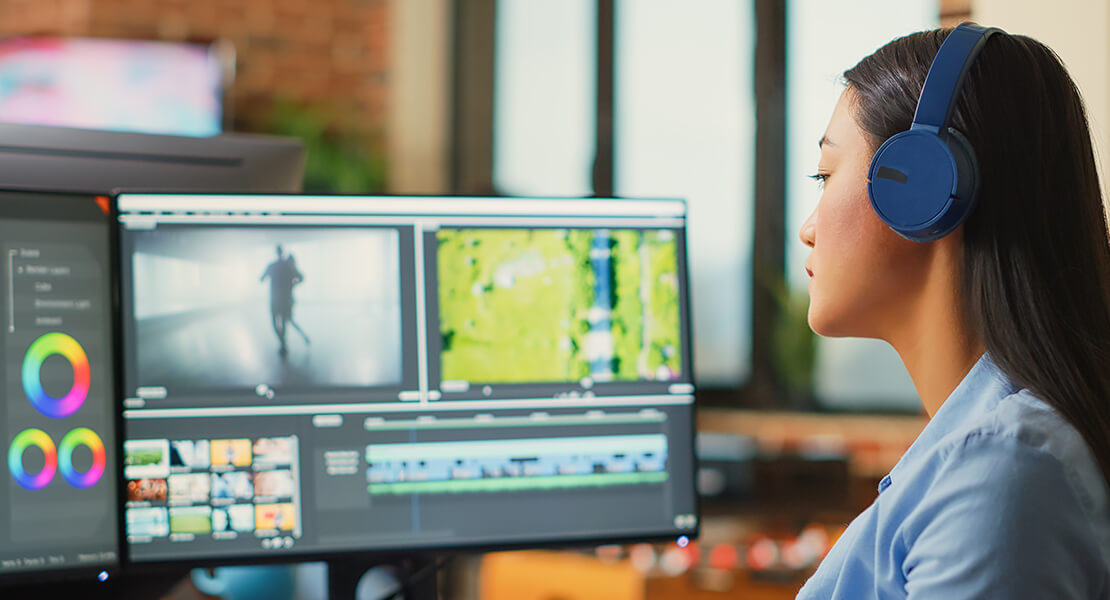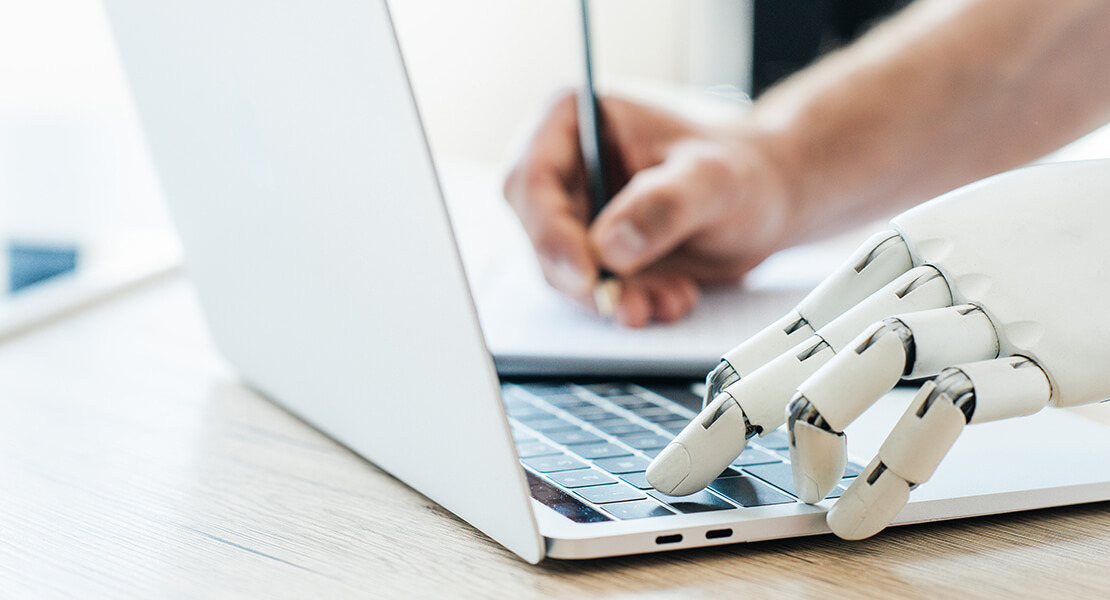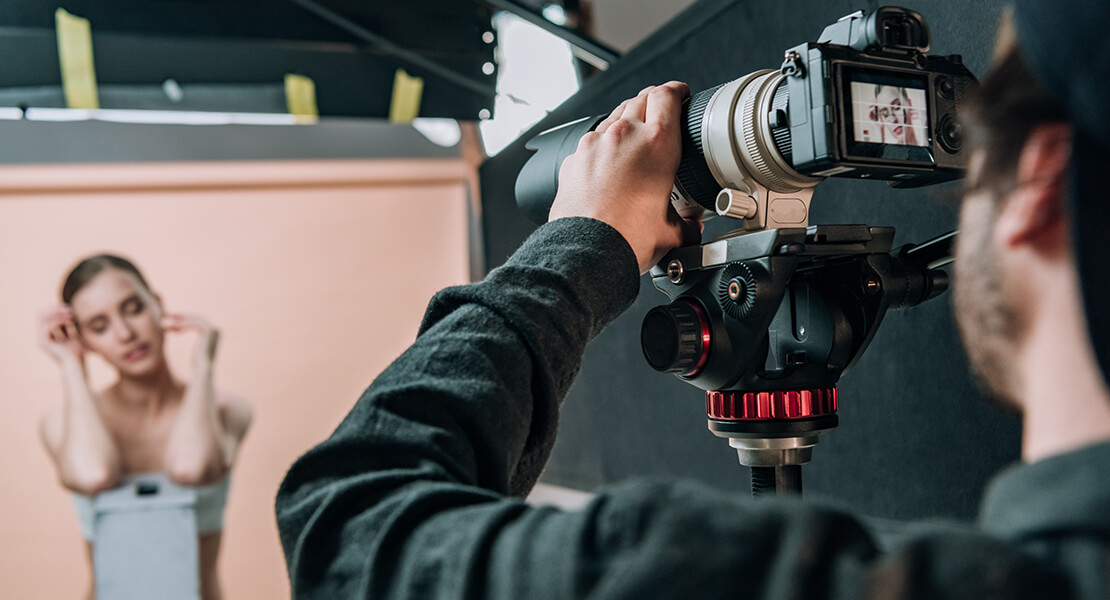
Let’s not sugar-coat it—AI is transforming video production in ways we never imagined a few years ago. What was once a painstakingly manual process is now being supercharged by smart tools that think, analyse and automate. But here’s the key thing: AI isn’t replacing creatives—it’s empowering them.
If you’re in the business of making video content—or even just dabbling in it—this is your moment to lean in and get ahead. Because the future of video? It’s already here, and AI is driving the camera.
From Concept to Script: AI as Your Creative Assistant
Ever stared at a blank page wondering how to start your next script? We’ve all been there. Now, AI can generate rough drafts, brainstorm ideas, and even analyse past content to suggest what’s likely to resonate with your audience. Tools like ChatGPT, Jasper, and others can help you shape the narrative before you even touch a camera.
It’s not about handing the whole job over to a robot—it’s about speeding up the dull bits so you can focus on the magic. You’re still the storyteller. AI just gives you a head start.
But it goes further than just writing help. AI is now being used to assess audience preferences, trending topics, and high-performing content within your niche. It can help you identify what themes, styles, or formats are likely to land well—giving you a data-backed foundation for your creative direction. It’s like having a research assistant who never sleeps.
Some AI tools can generate full outlines, breaking your ideas down into structured acts with suggested dialogue, voiceover cues, and even emotional tone. If you’re working in marketing or branded content, AI can analyse your brand’s tone of voice and mimic it throughout the script, maintaining consistency across your campaigns.
For teams, this means faster collaboration. AI can generate script versions for review, freeing up your writers to refine rather than start from scratch. For solo creators, it’s a boost of creative momentum when you need it most.
And if you’re dealing with multiple formats—say a video script, blog post, and social captions—AI can repurpose your core message across each medium, saving you time and ensuring brand alignment. Bottom line? AI doesn’t kill creativity—it clears the path for it to thrive.

Faster, Smarter Editing
Post-production has traditionally been one of the most time-consuming parts of video production. But not anymore. AI-driven editing software can now analyse hours of footage and pick out the best takes in minutes. It can auto-cut, stabilise shaky shots, colour-correct, and even match your edits to the beat of the music.
If you’re working to tight deadlines or juggling multiple projects, this isn’t just helpful—it’s a game-changer. You get your time back without compromising quality. And for solo creators or small teams, it means you can punch well above your weight.
What’s exciting is that AI editing isn’t just about speed—it’s about smart choices. These tools use object detection, facial recognition, and sentiment analysis to find the moments that matter. Want to highlight every time someone smiles during an interview? AI can do that. Need to automatically crop and reframe content for vertical or square formats? Done.
AI also simplifies repetitive tasks like syncing audio and video, removing background noise, or applying branded templates and transitions. And if you’re editing content in bulk—say for a product line or series—it can auto-generate multiple versions with slight adjustments for each target audience.
Some AI tools even suggest changes as you go, flagging pacing issues, recommending b-roll inserts, or highlighting low-engagement areas based on previous viewer data. You’re not just editing—you’re optimising in real time.
For agencies and brands, this means quicker turnaround times without increasing headcount. For freelancers, it means more bandwidth to take on new clients or focus on the creative aspects that actually need your personal touch. And for beginners? It removes the intimidation factor and makes professional editing accessible.
In a world where content is king but time is short, AI editing gives you the best of both: speed and polish. And that’s a combination no creator can afford to ignore.

Voiceovers and SFX: Reinvented by AI
Need a voiceover but don’t have the budget for a voice actor? No problem. AI voice generators can now produce natural, expressive speech in multiple languages and tones. Some even allow you to clone your own voice and use it for future content.
Sound design has had an AI upgrade too. Platforms can now automatically suggest music, sync effects, and even create soundscapes from scratch based on the mood of your video. You don’t need to be an audio engineer to get professional sound.
What’s remarkable is the realism. AI voice tech has moved well beyond robotic monotones. Today’s platforms can inject emotion, adapt pacing, and mimic regional accents with startling accuracy. Whether you’re producing a corporate explainer, a game trailer, or a multilingual campaign, AI lets you localise with ease and scale without limits.
For content creators working across multiple formats—podcasts, short-form videos, and social reels—this opens up a new level of agility. You can instantly produce different versions of your audio for different platforms, audiences, or purposes, all without re-recording.
On the sound effects front, AI doesn’t just match audio to visuals; it can anticipate what your video needs. For example, if your scene shows rain, the system can generate layered rainfall ambience, thunder rumbles, and wet footsteps, all in sync with the action. It also removes background noise, balances levels, and even suggests genre-appropriate background music—automatically.
And the best part? These tools are getting more affordable. What once required expensive studio equipment and teams of sound designers is now available via intuitive web platforms or plug-ins. It’s democratising high-quality audio production and giving creators the confidence to focus on storytelling without technical hang-ups.
AI in Animation and VFX
Animation used to be labour-intensive. Frame by frame. Pixel by pixel. Now? AI can assist with everything from in-betweening frames to generating realistic motion, backgrounds, and even characters. It’s speeding up production timelines and reducing costs while opening the door for more experimentation.
Even in live-action, AI is helping create blockbuster-level visual effects without a Hollywood budget. Think AI-generated sky replacements, depth mapping, and scene enhancements—all in a fraction of the time traditional methods would take.
But we’re not just talking about saving time—we’re talking about unleashing creativity. AI-driven animation tools can now generate storyboard drafts, animate facial expressions from audio input, and even apply realistic physics to character movements. You can create compelling sequences with just a few inputs and let AI handle the heavy lifting.
For indie animators, this is revolutionary. You no longer need a team of 20 to produce something that looks high-end. Even large studios are streamlining their pipelines, using AI for rotoscoping, motion tracking, and background generation—areas that previously ate up both time and budget.
In the world of VFX, AI is accelerating everything from green screen keying to 3D compositing. It can track movement with uncanny precision, apply lighting effects that match your scene, and fill in missing data when needed. This not only increases efficiency but also allows for last-minute creative changes that would’ve been unthinkable before.
We’re also seeing the rise of real-time AI rendering, where changes to environments, characters, and lighting can happen instantly—no overnight rendering needed. This is opening up virtual production on a wider scale, allowing filmmakers to see final shots live on set, just like in a video game engine.
The bottom line? AI isn’t replacing artists—it’s giving them more room to create, more tools to experiment, and more ways to bring their ideas to life without the usual technical and financial barriers.
Hyper-Personalisation at Scale
In the age of content saturation, personalisation is the key to grabbing attention. AI allows you to create thousands of video variations, each tailored to a specific audience, location, or even individual viewer.
Imagine sending a personalised video to each customer, addressing them by name, showing products they’re likely to want, and ending with a bespoke offer—all automated. That’s not the future. That’s now.
AI-powered personalisation is redefining how brands communicate with their audiences. It’s no longer about one-size-fits-all messaging. It’s about creating micro-targeted experiences that feel human, timely, and relevant—at scale. From personalised email campaigns with embedded videos to dynamic website headers that change based on user behaviour, video is becoming hyper-responsive to individual needs.
Tools like Synthesia, Idomoo, and Rephrase.ai allow marketers to personalise voiceovers, graphics, and on-screen messaging automatically. You can plug in customer data like name, location, purchase history, or even weather and generate videos that speak directly to that user—literally and visually.
Retailers are using this to recommend products based on browsing history. Banks are using it for account updates and customer service. Fitness brands are creating personalised coaching clips based on user goals. The impact? Higher engagement, stronger conversion rates, and a deeper sense of connection between viewer and brand.
Even more impressively, personalisation isn’t confined to pre-recorded content. AI now supports real-time personalisation, adapting videos as they’re being watched based on viewer input or choices—like a choose-your-own-adventure format.
In 2025, brands that treat their audience like individuals—rather than faceless clicks—will win the race for attention. Hyper-personalisation isn’t a gimmick. It’s becoming the new standard for meaningful engagement in an overly saturated content world.

Real-Time Feedback and Performance Optimisation
Once a video goes live, AI doesn’t clock off. It keeps working behind the scenes, analysing how your audience is responding. Are they dropping off after five seconds? Are they watching till the end but not converting? AI tools provide instant insights, so you can tweak and optimise on the go.
You’re no longer waiting for a campaign to end before you see results. With real-time data and predictive analytics, you’re making smarter decisions, faster.
Today’s AI-driven analytics platforms don’t just show you who watched your video—they tell you why people engaged or bounced. From heatmaps that show viewer focus to drop-off timelines and A/B test results, AI is breaking down performance in granular detail. You’ll know which scenes hit the mark and which bits need trimming, all within hours of publishing.
This immediate feedback loop empowers creators to fine-tune their content quickly. Want to test two different thumbnails or opening hooks? AI tools will show you which version grabs attention more effectively. Curious if your call to action is landing? Real-time engagement tracking can reveal how viewers are responding—and where you’re losing them.
It doesn’t stop there. Predictive analytics can also forecast performance based on early user behaviour. If your video gets strong engagement in the first hour, AI can alert you to boost it with paid promotion. If viewers are dropping off early, it might recommend changes before the video even finishes its first day.
In a world where algorithms favour quick engagement and relevance, speed is everything. With AI, your video strategy becomes agile, responsive, and continuously improving. You’re not just reacting to audience behaviour—you’re anticipating it. That’s the kind of edge every modern content team needs in 2025.
Virtual Production and Synthetic Media
We’re also entering the age of virtual production—where entire sets, environments, and even people are generated using AI and real-time rendering. You don’t need to fly to a desert or rent a castle. You can build it digitally and shoot it from your local studio.
Synthetic media is pushing boundaries even further. From digital doubles to AI avatars that host your videos 24/7, the possibilities are endless. Yes, it raises ethical questions. But handled responsibly, it unlocks new creative potential.
Virtual production blends the physical and digital worlds to create hyper-realistic environments without ever leaving the studio. Using LED walls, real-time rendering engines (like Unreal Engine), and motion capture, you can shoot scenes that look like they were filmed on location—only faster, cheaper, and more flexibly.
AI steps in to handle tasks like lighting simulation, weather effects, and background generation. Need a bustling street in Tokyo or a quiet coastal village at sunset? AI can render it in real time, perfectly synced to your camera’s perspective. This not only cuts travel and logistics costs but also dramatically reduces your carbon footprint—a huge win for sustainable production.
Synthetic media takes things one step further. With digital humans and AI-generated presenters, you can scale your content like never before. Imagine an AI avatar delivering daily news updates or customer support videos around the clock, in any language, without ever needing a break. This is especially powerful for e-learning, marketing, and global communication.
Of course, this new territory raises questions around authenticity, consent, and deepfake misuse. But with ethical safeguards in place—like full disclosure, clear licensing, and transparency about what’s synthetic—these tools become powerful creative assets, not threats.
In short, virtual production and synthetic media aren’t just trends. They’re reshaping what’s possible in storytelling. And if you’re in video production today, you’re no longer limited by location, budget, or even reality itself.

AI Doesn’t Replace Creativity—It Supercharges It
Let’s clear this up: AI is a tool. A powerful one, yes—but it can’t replace human intuition, emotion, or storytelling. It can help you work faster, smarter, and more strategically, but the spark still comes from you.
Creativity is still the heart of video production. AI just gives you more freedom to flex it.
Think of it this way: AI handles the groundwork, giving you more headspace to focus on the moments that truly matter—the pacing of a scene, the subtle shift in tone, the emotional arc of your narrative. It’s like having a tireless assistant who’s brilliant with logistics, freeing you up to be fully immersed in the creative flow. And that’s where your real value lies.
AI also encourages experimentation. You can prototype ideas quicker, test visual styles instantly, and iterate in ways that would’ve taken weeks before. This means you’re no longer limited by time or resources—you’re free to explore, refine, and take creative risks with confidence.
More importantly, AI levels the playing field. You don’t need a huge budget to produce standout work anymore. Whether you’re a solo filmmaker, a small team, or a large agency, AI empowers everyone to achieve more—without diluting the magic that makes your content yours.
So, What Should You Do Now?
If you’re not already exploring AI in your workflow, now’s the time. Start small—experiment with script generation or auto-editing tools. See what fits. Don’t be afraid to test, learn, and adapt.
And if you’re already using AI? Push it further. Look at how you can integrate it across your entire production pipeline—from planning and shooting to publishing and analysis.
The bottom line? The future of video production is faster, more agile, and more accessible than ever. And AI is the engine driving it all.
Begin by identifying the bottlenecks in your current workflow. Is it the editing queue? The script approval process? The post-production lag? There’s likely an AI tool out there that can help lighten the load. Build your AI toolkit gradually, focusing on tools that complement your strengths and automate your weaknesses.
Importantly, bring your team along for the ride. Upskilling with AI is becoming a must in creative industries, and those who embrace the change will be more equipped to lead. Attend webinars, join AI-focused forums, and stay curious. The tools are evolving rapidly—and so should your skillset.
Because here’s the truth: those who wait for perfection will be left behind. Those who explore and evolve will shape the future.
Final Words
AI isn’t some distant promise—it’s already reshaping how we create, edit, and
share video. The tools are here, the technology is moving fast, and the
possibilities are expanding every day. But here’s the most exciting bit: it’s
not about replacing the filmmaker, the editor, or the creative mind. It’s about
giving you more power to bring your ideas to life, faster and more efficiently
than ever before.
Whether you’re a solo creator, part of a small agency, or running large-scale
campaigns, embracing AI can unlock new levels of creativity, flexibility, and
impact. The future of video production isn’t just about staying relevant—it’s
about staying inspired.
So take the leap, explore what AI can do, and let it enhance—not
overshadow—your creative voice. Because in the end, it’s not just the tech that
makes a video unforgettable. It’s your story.
And if you’re interested in cutting-edge video production for your business, feel free to contact us at Spiel for a totally free of charge strategy consultation.

